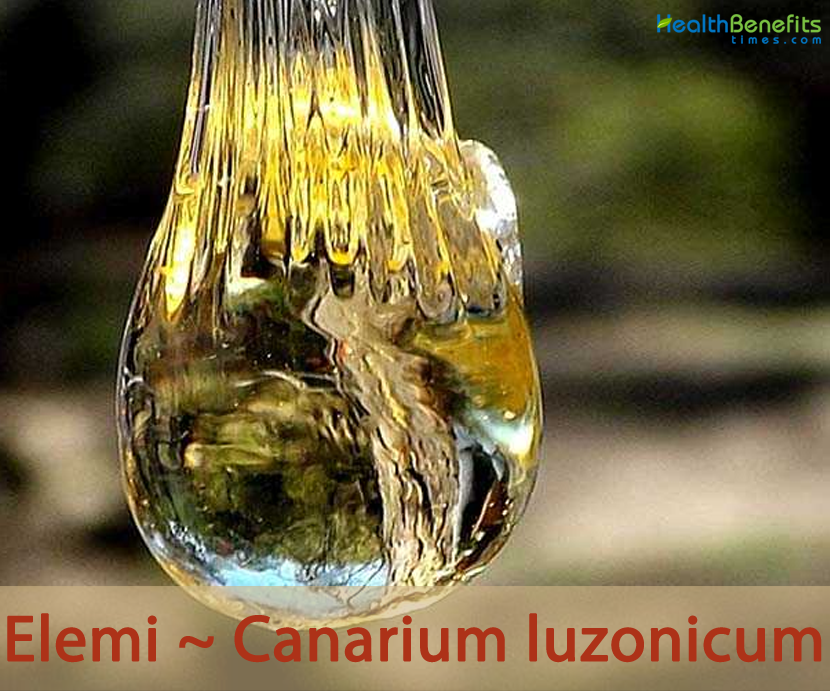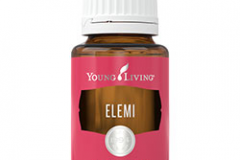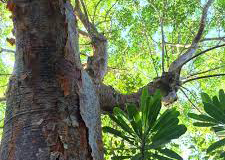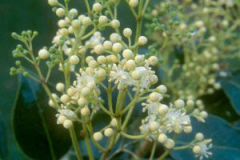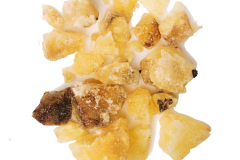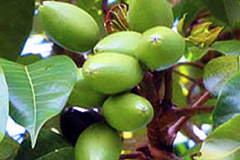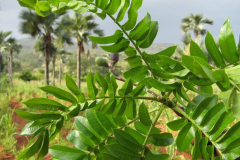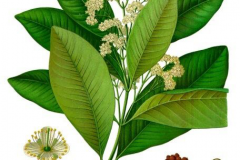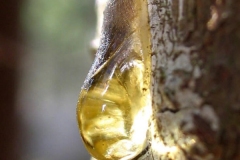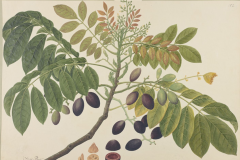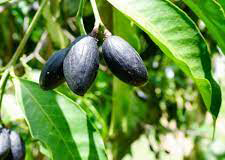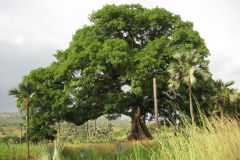| Elemi Quick Facts | |
|---|---|
| Name: | Elemi |
| Scientific Name: | Canarium luzonicum |
| Origin | Philippines but it is also found in South and Central America, Australia |
| Shapes | Broadly ovoid to ellipsoidal fruit, circular to bluntly triangular in cross-section, 4 to 5 centimeters long, 2 to 2.5 centimeters wide |
| Health benefits | Support bronchitis, catarrh, extreme coughing, mature skin, scars, stress, wounds, muscular pain, migraine, joint pain and headache |
| Name | Elemi |
|---|---|
| Scientific Name | Canarium luzonicum |
| Native | Philippines but it is also found in South and Central America, Australia, Brazil, India, the Malay peninsula, and Moluccas |
| Common Names | Elemi, Manila elemi-tree, Elemi canary-tree, Elemi oil, Java almond, Manila elemi, Oily pili, Pili nut |
| Name in Other Languages | Afrikaans: Elemi Albanian: Rëshirës Amharic: Emīmī (ኤሚሚ) Arabic: Iilimi (إيليمي) Armenian: Elemi (էլեմի) Azerbaijani: Elemi Bengali: Elemi Bulgarian: Elemi (елеми) Burmese: Hkyitsuu (ချစ်သူ) Chinese: Āi lái mǐ (埃莱米) Croatian: Elemi Czech: Elemi Danish: Elemi Dutch: Elemi English: Elemi, Manila elemi-tree, Elemi canary-tree, Elemi oil, Java almond, Manila elemi, Oily pili, Pili nut Esperanto: Elemi Estonian: Elemi Filipino: Elemi Finnish: Elemi, Manilanelemi French: Elemi, Arbre à baume, Élémi de Manille, Élémi sauvage Georgian: Elemi (ელემი) German: Elemi, Elemiharz, Manilaelemi, Manilaelemibaum, Elemibaum, Elemibitter Greek: Elemi Gujarati: Ilēmī (ઇલેમી) Hausa: Elemi Hebrew: אלמי Hindi: Elemi Hungarian: Elemi Icelandic: Elemi Indonesian: Elemi Irish: Elemi Italian: Elemi Japanese: Eremi (エレミ), Manira eremi Javanese: Elemi Kannada: Elemi Kazakh: Elyemi (элеми) Korean: elle mi (엘레 미) Kurdish: Elemi Lao: Siboed (ສິບເອັດ) Latin: Elemi Latvian: Elemi Lithuanian: Elemi Macedonian: Elemi (елеми) Malagasy: Elemi Malay: Elemi, Kedongdong, Kenari Malayalam: Elemi Maltese: Elemi Marathi: Ēlēmī (एलेमी) Mongolian: элми Norwegian: Elemi Oriya: ଏଲିମି Pashto: یمی Persian: Elemi Polish: Elemi Portuguese: Elemi, Elemi-de-Manilha, goma-limão Punjabi: Hāthī (ਹਾਥੀ) Romanian: Elemi Russian: Eleyi (элей), Elemi Serbian: Elemi (елеми) Sindhi: ايلمي Sinhala: Elemi Slovenian: Elemi Spanish: Elemi, Árbol a brea, Brea blanca Sundanese: Elemi Swedish: Elemi, Manila-elemi Tajik: Elemi (элеми) Tamil: Elemi Telugu: Elemi Thai: Elemi Turkish: Elemi Ukrainian: Elemi (елеми) Urdu: ہیلی Uzbek: Elemi Vietnamese: Elemi Welsh: Elemi Zulu: Elemi |
| Plant Growth Habit | Large, evergreen tree |
| Growing Climates | Lowland rainforest, Primary forests at low and medium elevations |
| Plant Size | Up to 30 m (100 ft.) high with a bole that can be a meter or more in diameter upon maturity |
| Bark | Bark surface smooth to flaky, scaly or dippled, often greyish, inner bark sometimes laminated, pinkish or reddish-brown, with strong resinous odor and clear sticky or oily exudate |
| Leaf | Leaves are alternate, pinnate, and about 30 centimeters long, commonly with three opposite pairs and a terminal leaflet |
| Flower | Inflorescence axillary, paniculate; male flowers 2.5-4 mm long, female ones 6-8 mm long, stamens 3-6 in the male and 6 in the female flower |
| Fruit Shape & Size | Broadly ovoid to ellipsoidal fruit, circular to bluntly triangular in cross-section, 4 to 5 centimeters long, 2 to 2.5 centimeters wide |
| Seed | Seed with palmatifid to 3-foliolate and variously folded cotyledons |
| Flavor/Aroma | Peppery, balsamic, lemony, spicy, warm aroma reminiscent of Frankincense Oil, with an exquisite drydown of fine woody-green, balsamic undertones |
| Plant Parts Used | Bark, resin |
Plant Description
Elemi is a large, evergreen tree that normally grows about 30 m (100 ft.) high with a bole that can be a meter or more in diameter upon maturity. The plant is found growing in lowland rainforest, primary forests at low and medium elevations. Bark surface of the tree is smooth to flaky, scaly or dippled, often greyish. Inner bark is sometimes laminated, pinkish or reddish-brown, with strong resinous odor and clear sticky or oily exudate. Pith of twigs usually contains vascular strands.
Leaves
Leaves are alternate, pinnate, and about 30 centimeters long, commonly with three opposite pairs and a terminal leaflet. The leaflets are smooth, oblong-ovate, 12 to 20 centimeters long and 3 to 7 centimeters wide, smooth and shiny on both sides, pointed at the apex, rounded or obtusely pointed at the base.
Flower
Flowers are clustered and borne on large compounded inflorescences. Male flowers are 2.5-4 mm long while female ones are 6-8 mm long. Normally 3-6 stamens are found in the male and 6 in the female flower.
Fruits
Fertile flowers are followed by broadly ovoid to ellipsoidal fruit, circular to bluntly triangular in cross-section, 4 to 5 centimeters long, 2 to 2.5 centimeters wide, and glabrous. They are normally smooth with a single seed.
Health benefits of Elemi
Listed below are some of the popular health benefits of using Elemi
1. Cleansing/Purifying
Burning Elemi incense on a charcoal disc produces smoke that is cleansing, purifying, grounding and balancing. It can be used to prepare your space for meditation and prayer as it is thought to enhance psychic abilities and strengthen connection to divine forces. Emotionally, Elemi communicates a balancing action that allows you to come fully into your center, allowing for deeper meditation.
2. Stress/Anxiety
With its fresh, citrus scent, Elemi can be used to stimulate mental ability and is especially useful when you are suffering from stress, anxiety and nervous exhaustion. It has stimulating properties which can help to perk you up if you are feeling sluggish and helps to clear the mind of mental fog. Burning this incense is also thought to help to dispel loneliness, uplift one’s mood and create a more positive outlook on life.
3. Insect Repellent
Like most tree resins, Elemi is a powerful insect repellent, effective against mosquitoes, ants, midges, moths, flies and fleas. Burn this incense outside to create an uplifting, meditative space and to keep biting insects at bay.
Traditional uses and benefits of using Elemi
- Manila elemi (the oleoresin obtained from the tree), and the essential oil distilled from the resin, have a long history of medicinal use.
- They are considered to be antibacterial, antifungal, anti-rheumatic, antiseptic, antispasmodic and rubefacient.
- A corn-sized drop of the resin is taken with water in the treatment of fevers and chills.
- Oleoresin is applied externally to arthritic and rheumatic joints, boils, abscesses, furuncles, burns and sores.
- It is heated and applied to the chest as a poultice to stop severe coughing.
- The tree bark is commonly used for postpartum baths.
- The essential oil is an ingredient of a commercial preparation called ‘Lysout’, a natural anti-lice foaming gel that also contains Echinacea purpurea.
- Resin is used as an herbal medicine to treat bronchitis, catarrh, extreme coughing, mature skin, scars, stress, and wounds.
- It is used medicinally as stimulant, rubefacient and anti-rheumatic and for the treatment of respiratory ailments.
- The Expectorant action treats respiratory problems like cough, flu, chest congestion, bronchitis.
- It helps to break the Phlegm deposits in the respiratory tract and lungs.
- It has a harmonizing effect on the mind, body, and spirit. It regulates the emotions in the body.
- The Antiseptic property restrains the growth of microbes, bacteria, and fungi.
- Topical application of this oil prevents Wounds and Cuts from becoming septic.
- Being an Analgesic, it reduces muscular pain, migraine, joint pain, headache and pain associated with fever and inflammation.
- It has a stimulating effect on the body. It regulates circulation, secretion, digestion, excretion, brain and nervous system functions.
- It tones up the tissues and gives a feeling of vigor. It gives strength to the body and boosts the Immune system.
- The skin softening property helps to get rid of dead cells. It reduces Wrinkles and fine lines.
- It is useful in maintaining skin elasticity and suppleness.
- It improves the digestive and excretory system. It enhances the metabolism.
- Essential oil enhances circulation, encourages the growth of new skin and hair, contributes and maintains hydration, conditions, and prevents infections.
Culinary Uses
- The seeds can be consumed raw or cooked.
- Nuts are sweet and have a delicious flavor.
- Oil from seed is used in cooking.
- Fruit pulp is cooked while young shoots can be eaten raw.
- Sweet nuts have a delicious flavor when roasted and are served like almonds.
- They can also be used in confections, ice cream, nut milks etc., and as an adulterant to chocolate.
- Oil can be extracted from the fruit pulp.
- Young shoots can be consumed raw.
- It can be eaten in salads.
- The seed kernels are used for food, both raw and cooked.
- Edible oil can be extracted from the seeds, and the pulp can be stewed but is somewhat insipid.
- The young shoots can be boiled and eaten as a vegetable.
- Nuts when roasted have a delicious flavor. Also used in confections, ice creams, as adulterant to chocolate.
Other Facts
- It is a great source of a fragrant oleoresin called elemi which has a wide range of uses in food, medicine, and industrial applications.
- A single tree produces 4 – 5 kilograms of this resin.
- An oily resin called Manilla elemi is obtained from incisions in the bark.
- It is used in varnishes and inks; for caulking boats; torches; perfumery and for various medicinal applications.
- It can be used for the same purposes as turpentine.
- Tannin of reasonable quality is obtained from the bark.
- The wood is not very hard. It is used for light construction.
- However, the tree is more highly valued for its resin and edible seed and so is little harvested for its wood.
- The wood is suitable for internal use as a general utility timber for planking, cladding, plywood, flooring, furniture, packing cases, pallets and general carpentry work.
- Elemi resin is chiefly used for the manufacture of printing inks, surface coatings for textiles and paper, incense, linoleum, oilcloth, waterproofing compositions and as an insect repellent in cabinets.
- Locally it is used in torches, as a firelighter, to caulk boats and to dress transmission belts and conveyors.
- In China it has been applied for the manufacture of transparent paper for window panes.
Precautions
- The coat surrounding the kernel should be removed since it can cause diarrhea.
- Avoid use during pregnancy and breast feeding.
- Do not use undiluted.
- It may cause skin irritation.
References:
https://pfaf.org/user/Plant.aspx?LatinName=Canarium+luzonicum
https://gd.eppo.int/taxon/CNBLU
https://en.wikipedia.org/wiki/Canarium_luzonicum
https://tropical.theferns.info/viewtropical.php?id=Canarium+luzonicum
http://www.theplantlist.org/tpl1.1/record/kew-2695949
https://uses.plantnet-project.org/en/Canarium_(PROSEA_Exudates)
http://www.stuartxchange.com/Sahing.html
https://uses.plantnet-project.org/en/Canarium_luzonicum_(PROSEA)
https://plants.usda.gov/home/plantProfile?symbol=CALU10


